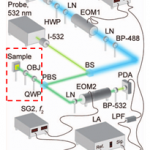Congratulations to Prof. Kay Park! He recently received a University of Utah Seed Grant for the “Development of Scanning Near-Field Thermoreflectance Microscopy for Nanoscale Temperature and Phonon Mean Free Path Spectra Mapping”.
Understanding of thermal transport at the nanoscale has increasing importance as device sizes shrink and applications for nanotechnology become more prevalent. At these length scales, the device size is often comparable to the mean free paths (MFPs) of energy carrying particles, particularly phonons for semiconducting and dielectric materials, causing the selective scattering of phonons and ballistic heat conduction across the boundaries. The reduction of the thermal conductivity due to such non-Fourier heat conduction has a huge impact on heat dissipation of nanoelectronic and photonic devices, often leading to the operation failure due to overheating. However, the spectral distribution of phonons and its impact to the thermal conductivity is not yet fully understood, mainly due to lack of adequate instrumentation of spectral phonon transport properties. 
The ultimate goal of the proposed research direction is to directly measure a nanoscale and broadband probing of phonon spectra for fundamental research of nanoscale heat conduction. To this end, we propose to implement the broadband frequency-domain thermoreflectance (BB-FDTR) scheme to scanning near-field optical microscopy (SNOM). The so-called scanning near-field thermoreflectance microscopy (SNTRM) is based on the hypothesis that tip-scattered near-field optical signal essentially has the same information about a sample’s optical properties as the conventional optical reflectance signal except the subwavelength spot size, and thus should be sensitive to the temperature change. Therefore, a nanoscale thermoreflectance scheme will be possible by measuring temperature-dependent tip-scattered near-field light, which can provide the thermal conductivity accumulation function at the nanoscale as a function of the phonon MFP.